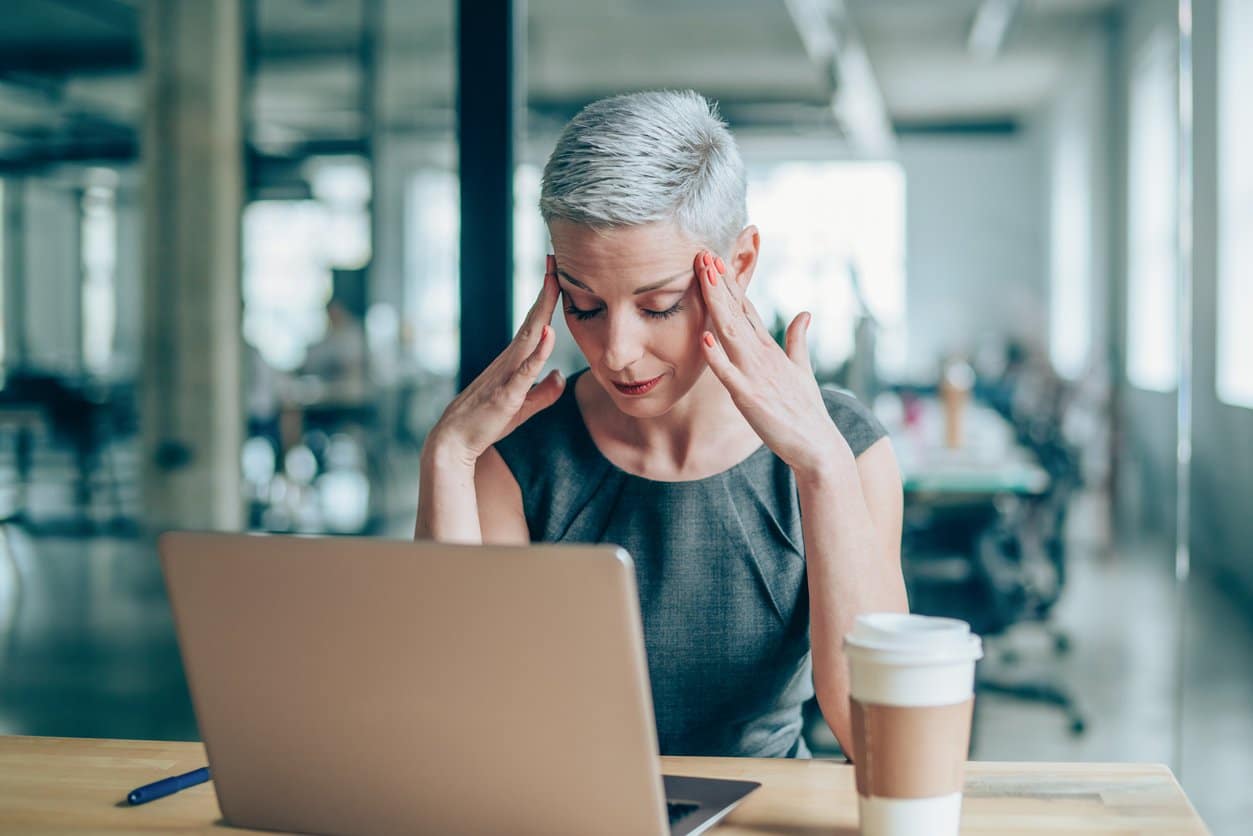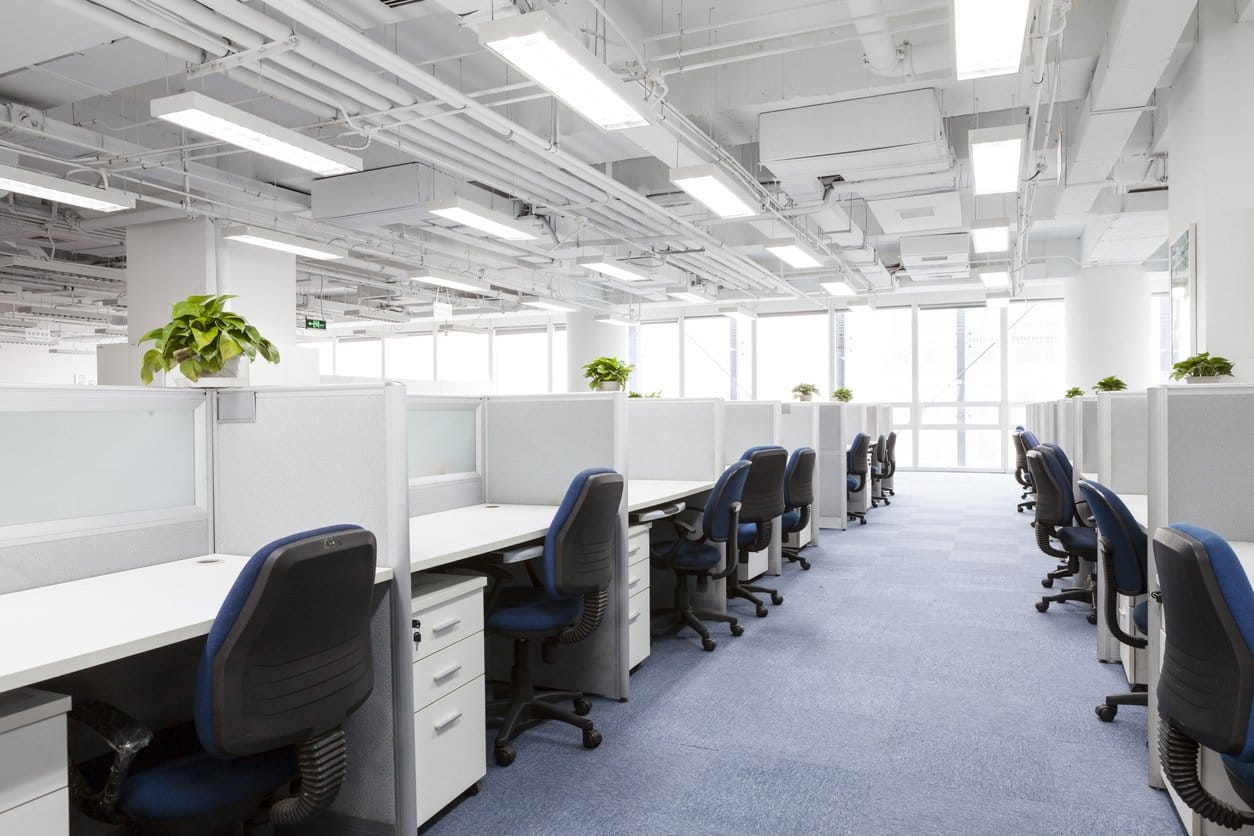With more people returning to work from COVID-19 lockdown, employees are noticing how much they hate their office lighting. Overhead fluorescent lights can irritate you with their humming or even make you look like you just crawled out of a grave- but do fluorescent lights really affect vision? More importantly, how exactly do you block fluorescent lighting?
You might find yourself squinting to try to filter out some light or blinking excessively. Maybe you experience a migraine that won’t go away. Your eyes may even get dry or blurry. Whatever your symptoms are, they can be frustrating, uncomfortable, and inconvenient, thus affecting your productivity at work.
Furthermore, if you work on a computer you could be exacerbating the issue with fluorescent light bouncing off of laptop screens and monitors, furthering creating problems with double vision, headaches, migraines and more. The urge to block fluorescent lights is a common desire among office workers with poor lighting.
Alternate Solution to Blocking
Blocking out the lights can have some serious drawbacks, like not having enough light or even creating fire hazards. Consider using light cover filters instead to help diffuse the light and create more natural lighting.
But since fluorescent lighting is so widespread, it’s pretty challenging to avoid. You can find these bulbs almost everywhere- in office cubicles, schools, malls, and grocery stores. In fact, fluorescent bulbs are less expensive to acquire compared to their lifespan (up to 13 times longer than the typical incandescent bulbs). This makes them the #1 lighting option across the US. And if that’s not enough, your eyes pay the ultimate price if you work (or stay) in rooms lit by fluorescent bulbs.
Do You Have Fluorescent Light Sensitivity?
Vision Council 2015 study statistics, there are many symptoms associated with overexposure to fluorescent bulbs.
- 22.8% report experiencing dry eyes
- 23.3% report experiencing blurred vision
- 24.0% report experiencing headache
- 32.6% report experiencing back/shoulder/neck pain
- 32.8% report experiencing eye strain
Reducing headache and blurred vision associated with flickering displays is not a walk in the park. Proper illumination or lighting has long been regarded as a vital workplace aspect affecting visual comfort, says another study.

A different 2007 study also asserts that task-lighting does have a substantial impact on productivity. Yet there are many – often contradicting – issues you should consider when setting up the perfect work environment: visual ambiance, job stimulation, and optical performance.
If you work in an office, the chances are that you are sitting underneath fluorescent bulbs for 6-8 hours on the fly. Since switching off all the lights or getting a lamp may be out of reach, how can you block fluorescent lights when at work?
How To Dull or Block Fluorescent Lights In Office
Modifying your work environment is one of the most powerful ways to reduce eye strain and other related health problems. Here are some of our suggestions which, combined with the tips we shared in a previous article, should significantly help you avoid direct (and prolonged) exposure to the bright lights of fluorescent lights and LED lights:
Option #1 Make The Most of Natural Lighting
Fluorescent lights seem like the answer to all of our lighting issues. They’re more energy-efficient, they last longer, and most importantly, they save a dollar. But maybe you’ve been struggling with their flickering light for far too long and can’t stand its humming either. This is where natural lighting comes in handy. Locate workers near windows if that is possible in your space.
Natural Light Filters
Light covers that act as fluorescent light glare shields that also turn the bright light from overhead lights into more natural light.
Using natural light to reduce your dependence on LED and fluorescent lights can help you get some reprieve. If possible, try to relocate your desk closer to a window or partial skylight. But before you pick a spot, check the conditions from varying angles and at different times of the day. At certain hours (like in the late afternoon), you might get some glare off adjacent buildings, which can be a problem for those sensitive to UV light.
Option #2 Have a Few Wide-Brimmed Hats
It may seem obvious, but a circular, wide-brimmed hat can offer full coverage from bright, flickering, overhead lighting. While this solution can help to shade your eyes, it’s probably difficult to find an office setting where employees are free to wear hats whenever they want (not to mention hat hair).
If you can’t tolerate glaring fluorescent bulbs, seek permission from HR to wear one of these hats. Find a style that offers protection and compliments your sense of fashion (if it’s anything important). In the long run, you’ll find the hat a priceless asset during your day-long office schedule.
A baseball cap might also be a viable option but is often not as effective in blocking harsh fluorescent lighting or glare in the way a wide-brimmed, round hat would. It is also essential to check the extra sensitivities from the added weight a hat (or cap) can put on your head.
Option #3 Request to Use Incandescent or Other ‘Gentle’ Bulbs
Warm white LED or incandescent lights arguably provide the best lighting for eyestrain headache sufferers. Unlike fluorescent bulbs, they emit a warm glow with nominal blue light. Excess amounts of blue light have been shown by research to trigger migraine attacks.
Asking your HR department to replace overhead fluorescent lighting in favor of desk or floor lamps can be a great way to start. Task lighting on your desk can help. But dim light can also create an unsafe office environment.
But remember:
There’s a regulation by OSHA that requires offices (and other work settings) to have a certain degree of lighting.
Another problem with using different bulbs in different office zones is what we call “office lighting wars.” Many Americans admit that office lighting disputes are not unusual. But there’s an obvious conclusion to this debate. Workplace lighting is a clash of health and productivity- both individually and collectively. One such victim of office lighting wars sums up the scenario:
“Our cubicle farm office (…) is undergoing “lighting wars.” One person asked to have the lights above his cube removed because the glare gave him headaches. That prompted another person to ask if the lights above her cube could be taken out, and then another, and another. (…) Whole swathes of the open-plan floor were suddenly plunged into total or semi-darkness, with no light source but glowing monitors”.
ASK A MANAGER SERIES, Alison Green
Unfortunately, fluorescent bulbs are more efficient and affordable, making them a preferred option for many offices across the globe, but it is still worth the swipe.
Option #4 Take a Break, Take a Break, Take a Break!
If you’re a workaholic, don’t forget to take measured breaks away from your desk. They call it the 20-20-20 rule. Eye experts from the American Academy of Ophthalmology recommend using it when your weary eyes need a break; after 20 minutes of screen exposure, focus on an object 20 feet away from your desk. Do it for 20 seconds. This ‘rule of thumb’ applies to all digital devices, and those fluorescent bulbs hanging over your head are no exception.
Alternatively, try to sit in a quiet, dimly-lit room when out for lunch or any other break. Close your eyes and try relieving your back and shoulders of any fatigue. Periodic breaks in between intense work might be the magic bullet you never thought you needed, so don’t be afraid to take the plunge.
Option #5 Have Special Tinted Glasses at the Ready
If you can’t change the lights or the location of your desk, then it may be time to invest in light sensitivity glasses specially made to block fluorescent lights (or at the very least minimize direct exposure to UV light). There is a wide variety of colored glasses to choose from in the market. Keep in mind that the best lenses not only reduce the invisible flicker of LED or fluorescent lights but also filter the most dangerous rays of blue-green light.
Special Glasses to Block Fluorescent Lights
One of the more effective solutions are glare blocking glasses from Theraspecs
At the last resort (and we mean the very last!), wearing sunglasses can provide temporary relief while working. But it is not in any way a long term solution. Read about its drawbacks below.
Other Ways To Block Fluorescent Lighting
1. DON’T Wear Sunglasses Indoors!
As we mentioned, wearing dark sunglasses shouldn’t be a common practice in the workplace. For one, it can exacerbate light sensitivity for patients ailing from migraine attacks from bright lights.
This happens when your eyes become used to dim conditions, gradually making them more sensitive to sharp light. And as you can bet, this can cause even greater uneasiness.
“When we come out of the movie cinema in the middle of the day and face the bright sunlight, it causes discomfort [even for people without light sensitivity]. Wearing sunglasses inside has a similar effect.”
Dr. Bradley Katz, neuro-ophthalmologist & contributor on Migraine Again Podcast
But if your eyes hurt and you must wear dark shades in the office, opt for light sensitivity sunglasses instead; lest you want your eyes to dark adapt.
2. Invest in Fluorescent Light Filters
If you battle against migraines, heightened fatigue, eye strain, and Lupus flare-ups at work, you can quickly transform the bare, stress-inducing light in your workplace.
Investing in fluorescent light filters is one of the most cost-effective (and powerful) ways to block fluorescent lighting and transform the working atmosphere to benefit you and your colleagues. Of course, not all filters are of the highest quality. While weighing up your options, you will want to buy a filter that does more than soften light wavelengths.
For the most advanced light filter out there, choose ™ filters– Make Great Light products of exceptional quality. In addition to providing daylight quality lighting, the filter also creates a safer, more subdued environment for your workspace. It’s like having sunlight from windows or skylights right next to your desk.
Computer workers in the office that often get headaches or have trouble with night sleep patterns will benefits greatly.
Natural Light Filters
How to improve fluorescent lighting? Light covers that turn ordinary bulbs into more natural light.
The filter also works to absorb potentially harmful UV rays produced by fluorescent lights, guaranteeing you healthier ways to enjoy your workday- without the migraines. Using a NaturaLux™ fluorescent filters will also increase the perceived brightness of your indoor space while decreasing the amount of glare emitted.
Our products are not only innovative and affordable but also dynamic- providing you access to full-spectrum lighting like never before. Given these filters tone down the intensity of UV light and block direct glares, they protect users from migraines, anxiety, eyestrains, and other adverse effects of continued UVA exposure.
Finally, Naturalux helps employees stay alert and in the right state for productivity. Don’t block fluorescent lights, upgrade them with light filters.
Creating a Conducive Indoor Environment for Work
According to TCP, one of the biggest trends for office lighting in 2023 will be human-centric lighting.
By following the tips and recommendations outlined above, you can block fluorescent lighting that is impairing your productivity at work. Ultimately, you get to experience a tranquil, comfortable, glare-free indoor space any time, any day!
For more healthy tips on secure overhead lighting, at Make Great Lights and feel the difference.
Sources
003: The Dangers of Hiding in the Dark with Dr. Bradley Katz
https://www.theguardian.com/lifeandstyle/2018/may/28/blue-light-led-screens-cancer-insomnia-health-issues
https://www.aao.org/eye-health/tips-prevention/computer-usage
my office is fighting about overhead lighting, how to address an employee’s bad attitude, and more
https://www.thevisioncouncil.org/content/digital-eye-strain
https://pubmed.ncbi.nlm.nih.gov/18413962/
https://www.sciencedirect.com/science/article/abs/pii/S0003687006000160
